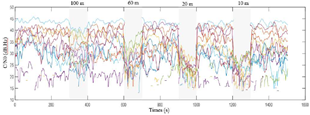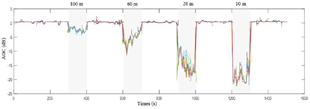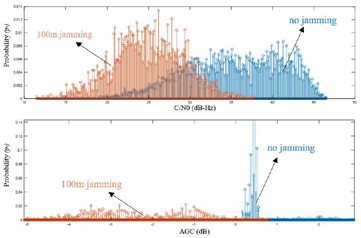Motivation
GNSS jamming poses a serious threat to GNSS users by
interrupting the signal reception and may cause outages. Alleviation and
detection of jamming are therefore important issues for real-world users. We
propose the Entropy-based [1] detector in which the entropy of AGC and C/N0 are
computed and used as the threshold and use an Android mobile phone as the GNSS
receiver which can provide AGC and C/N0 parameters. The GPS, Galileo, and
Beidou systems (L1, E1, C1 frequencies) are considered. The results show that entropy-based
detector provides lower false alarm probability compared with the LRT approach.
Figure 1 show the example devices which are used in these experiments.

Fig. 1. (a) GNSS Jammer (Celetialsmog), (b) Android mobile phone (Huawei mate 20)
Experimental setup and results
In this work, the C/N0 and AGC are measured and analyzed during both non-jamming and jamming events. For the first part, we store the AGC and C/N0 for one hour. Next, the C/N0, and AGC are collected when the distances between the jammer and mobile receiver are set to be from 10 to 100 meters, with an increment of 10 meters, as shown in figure 2 and 3, respectively. Then we use three satellite systems including GPS, Galileo, and Beidou (L1, E1, C1 frequencies) with 30-degree elevation cut-off. The collected AGC and C/N0 are analyzed and displayed as histograms. Figure 4 shows examples of distribution functions of AGC and C/N0 received from the GPS. The orange graphs represent the distribution functions of C/N0 and AGC with active jamming at 100 meters. The blue graphs display the distribution functions of C/N0 and AGC without jamming. The averages of C/N0 and AGC with jamming are lower than those without jamming. From these graphs, the average of C/N0 with 100 meters jamming is about 25.14 dB-Hz whereas that without jamming is 37.42 dB-Hz. Also, the average of AGC with and without jamming is -2.57 dB and 0.46, respectively. The 100-meter distance is considered because the AGC and C/N0 values are decreased when the distance is increased. If we estimate the threshold at the 100-meter distance, the jamming occurrences at closer than 100 meters can be detected.

Fig. 2. The effects of the jammers on the C/N0 parameter.

Fig. 3. The effects of the jammers on the AGC parameter.

Fig. 4. (a) Distribution functions of C/N0 and (b) Distribution of AGC without and with jamming at 100 meters (GPS)
Conclusions
We
have proposed the Entropy-based detector for jamming detection in mobile
phones. The C/N0 and AGC of GPS, Galileo, and Beidou (L1, E1, C1 frequencies)
system are considered to obtain the thresholds via the entropy method. At
100-meter jamming, we found that the errors by the thresholds of C/N0 and AGC
with the entropy-based detector are better than the LRT by about 3% and 4%,
respectively. For the proposed method, the errors by threshold performance of
the C/N0 threshold are inferior to the AGC by about 9%. In future works,
machine learning algorithms such as decision trees and support vector machines
can be applied to detect the jamming occurrences. Besides, the positions of the
jammer are estimated via the relationship between the GNSS parameter with and
without jamming at each distance.
References:
[1] C. Sakorn. (2021). Calculating AGC and C/N0 Thresholds of Mobile for Jamming Detection. ECTICON-2021. DOI: 10.1109/ECTI-CON51831.2021.9454850